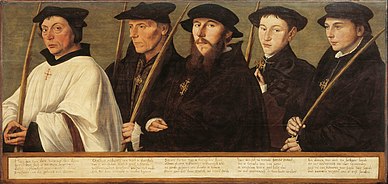Pilgrim
It has been suggested that this article be merged into Pilgrimage. (Discuss) Proposed since November 2023. |


A pilgrim (from the
the world (considered as a period of exile) or to the inner path of the spiritual aspirant from a state of wretchedness to a state of beatitude.[1]
History
Pilgrims and the making of
Persia in the Mithraic period, India, China, and Japan. The Greek and Roman customs of consulting the gods at local oracles, such as those at Dodona or Delphi, both in Greece, are widely known. In Greece, pilgrimages could either be personal or state-sponsored.[2]
In the early period of
Divine Providence. These travels often resulted in the founding of new abbeys and the spread of Christianity among the pagan population in Britain
and in continental Europe.
Modern era

Many religions still espouse pilgrimage as a spiritual activity.
Christ (such as Bethlehem, Jerusalem and the Sea of Galilee) or places associated with saints, visions and miracles such as Lourdes, Santiago of Compostela, Canterbury and Fatima
.


Places of pilgrimage in the
Himalayan peaks are sacred to both Hindus and Buddhists); caves (such as the Batu Caves near Kuala Lumpur, Malaysia); temples; festivals, such as the peripatetic Kumbh Mela, in 2001 the biggest public gathering in history;[4] or the tombs and dwelling places of saints (Alandi, Shirdi). Zoroastrians have as their main pilgrimage destinations the city of Yazd and the temples of Pir-e Sabz and Pir-e Naraki in Iran, as well as the cities of Navsari and Udvada
in India.
Beginning in 1894, Christian ministers under the direction of

A modern phenomenon is the cultural pilgrimage which, while involving a personal journey, is secular in nature. Destinations for such pilgrims can include historic sites of national or cultural importance, and can be defined as places "of cultural significance: an artist's home, the location of a pivotal event or an iconic destination".Christopher McCandless was 'a pilgrim perhaps' to Alaska in search of spiritual bliss.[12]
In culture
Some prominent literary characters who were pilgrims include:
- In the epic poem Divine Comedy, Dante Alighieri portrays himself as a pilgrim traveling through the afterlife realms of Hell, Purgatory, and Paradise.
- John Bunyan depicted multiple pilgrims (e.g., Christian – the protagonist, Faithful, Talkative, Christiana, Mercy, Old Honest, Mr. Fearing, Mr. Feeble-Mind, Mr. Ready-to-Halt, and Mr. Valiant) as well as false pilgrims (e.g., Formalist, Hypocrisy, and Mr. By-Ends) in his Christian allegory, The Pilgrim's Progress (1678)
- Wilfred of Ivanhoe, a Sir Walter Scott's book Ivanhoe
- A palmer plays a significant role representing Reason in Book II of Edmund Spenser's epic poem The Faerie Queene
See also
References
- user-generated source]
- JSTOR 1206041.
- ^ "The Celtic Saints". Heart O' Glory. 2007. Archived from the original on 2007-10-14. Retrieved 2007-10-23.
- ^ "Heart of Hinduism: Four Main Paths". iskcon.org. Archived from the original on 2015-11-15. Retrieved 2014-10-26.
- ^ "Noteworthy Events in the Modern-day History of Jehovah's Witnesses", Jehovah's Witnesses – Proclaimers of God's Kingdom, page 719, "1894 Traveling overseers that in time came to be known as pilgrims (today, circuit and district overseers) are sent out in connection with the Society's program for visiting congregations"
- ^ "Sweden", 1991 Yearbook of Jehovah's Witnesses, page 126
- ^ "Switzerland and Liechtenstein", 1987 Yearbook of Jehovah's Witnesses, page 123, "'Pilgrims' were traveling representatives of the [Watch Tower] Society, as circuit overseers are today. Their efforts contributed to the unity of the brothers and brought them into closer contact with God's organization. The Society would announce in Zion's Watch Tower the proposed itinerary of the pilgrim brothers, and congregations and smaller groups along these routes would then write and express their desire to be visited. The pilgrims were excellent speakers, and their public lectures were usually well attended. In 1913, for example, their audiences in Switzerland totaled some 8,000 persons."
- ^ "Development of the Organization Structure", Jehovah's Witnesses – Proclaimers of God's Kingdom, page 222, "[Beginning] in 1894, arrangements were made for the [Watch Tower] Society to have well-qualified speakers travel more regularly to help the Bible Students to grow in knowledge and appreciation for the truth and to draw them closer together. ...An effort was made to have each group in the United States and Canada visited twice a year, though not usually by the same brother. In selecting these traveling speakers, emphasis was placed on meekness, humility, and clear understanding of the truth as well as loyal adherence to it and ability to teach it with clarity. Theirs was by no means a paid ministry. They were simply provided with food and lodging by the local brothers, and to the extent necessary, the Society helped them with travel expenses. They came to be known as pilgrims. Many of these traveling representatives of the Society were dearly loved by those whom they served. A. H. Macmillan, a Canadian, is remembered as a brother to whom God's Word proved to be "like a burning fire."
- ^ "Part 1—United States of America", CMP'1975 Yearbook of Jehovah's Witnesses, page 83
- ^ a b Welsch, Chris (January 3, 2007). "Travelers define such a pilgrimage in many different ways". Star Tribune. Archived from the original on June 8, 2008. Retrieved 2008-03-11.
- ^ "Cultural Pilgrimage to Compostela". Circa Tours. February 17, 2008. Retrieved 2008-03-11.
- ^ "Into the Wild". cliffsnotes.com.
Literature
- Documentation, of a modern pilgrimage to Rome. Kerschbaum & Gattinger, Via Francigena. DVD. Vienna: Verlag EUROVIA, 2005. ISBN 3-200-00500-9
External links
Look up pilgrim in Wiktionary, the free dictionary.
 Media related to Pilgrims at Wikimedia Commons
Media related to Pilgrims at Wikimedia Commons- Medieval Pilgrims' Clothing Illustrations of 13th–16th century pilgrims, and links to photos of 16th century clothing made for pilgrimage
